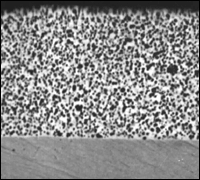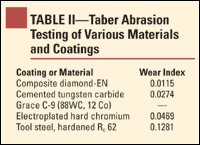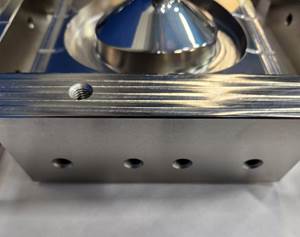The Environmental Benefits of Composite Electroless Nickel Coatings
Because of the negative environmental and health effects related to chromium, finishers are looking for a replacement. Composite electroless nickel coatings may be one solution…
The finishing industry is facing a greater challenge to reduce the environmental impact of its processes than ever before. Perhaps the paramount challenge is to replace chrome plating due to its negative environmental and health effects. The EPA has found chromium to potentially cause skin irritation and ulceration during short-term exposures. Long-term effects include damage to the liver, kidneys, circulatory system and nerve tissue, as well as skin damage and cancer.
In 1972, Congress passed the Clean Water Act, which protects our lakes, rivers, aquifers and coastal areas. It was amended in 1977. Under this law, most chromium limits were set by state and local environmental agencies. Under the recently proposed Metal Products and Machinery Rule (MP&M), the maximum daily limit for chromium would be 1.3 mg/liter and 0.55 mg/liter maximum monthly average. Not necessarily easy numbers to reach.
Due to this, chromium reduction has been a key focus of companies, the military, industry conferences, academia and legislation. Many applications have already been converted from chrome plating to other finishing operations. Because chrome is used so widely for varying purposes, it is impractical to expect to find a single replacement that will work in all applications.
While questions exist about the environmental ramifications of nickel, it is still clearly less problematic than chrome. For this reason, electroless nickel (EN) has been used to replace chrome in many decorative as well as functional applications, such as for corrosion and wear resistance. In applications requiring hardness and wear resistance, composite EN coatings have been even more successful in not only replacing chrome but actually surpassing the performance of hard chrome plating.
Composite EN coatings have codeposited particles dispersed throughout the coating layer as in Figure 1. These coatings, therefore, have all of the inherent features of electroless nickel as well as the properties of whatever particles are selected, such as hardness, wear resistance, lubricity, heat transfer, light absorption, etc. For this reason, composite EN coatings are better than chrome or any electrolytic or spray processes for non-line-of-sight applications.
Recent analysis has further demonstrated that these composite EN coatings not only have tremendous potential to replace chrome, but actually can be used to reduce nickel use and pollution as well. This interesting opportunity exists on three levels.
No Chrome Composite EN coatings use no chrome. The environmental problems inherent with plating and using chrome are therefore entirely eliminated.
Less Nickel Used
Composite EN coatings can be routinely produced with up to 40% by volume of codeposited particles. The implications are significant in four aspects:
- Most simply, this means that at least 40% less nickel is required to produce composite coatings of equal thickness to a conventional coating without such particles.
- Given the greater wear resistance of composite EN coatings versus conventional coatings, the deposit thickness of composite coatings can be significantly less than conventional EN coatings. This means even less nickel needs to be used.
- As such, composite EN coatings last longer, parts will need to be recoated or replaced less frequently. Again, resulting in even less nickel used.
-
The less nickel the plating shop uses, the longer the baths will last. This means less baths required, less waste treatment and less waste.
Less Nickel Released
Concern about the release of chrome, nickel and other metals into the environment does not stop at the plating shop’s door. As coatings wear, their constituents are released. Depending on the application, they can be released into work areas, food applications, sensitive assemblies and the environment as a whole. Composite EN coatings have the further advantage, therefore, of preventing the release of such metals based on the following four principles:
- Greater wear resistance of the composite EN coatings reduces the release of the coating into the environment.
- As the composite coating can be up to 40% inert particles, the coating released into the environment will be up to 40% less metal.
- As parts last longer, they are not discarded into the environment as often, and less replacement parts are required.
- Because composite EN coatings can be chemically stripped, used parts can be stripped and recoated, thereby reclaiming the nickel metal in solution form for recycling.
There is one other aspect worth considering. Chrome is often “over-plated” on parts with complicated geometries to achieve the correct deposit thickness in areas with lower current densities. Not only is this an excessive use of chrome plating, it also requires grinding the plated parts to the proper dimensional tolerances. This grinding naturally releases chrome metal into the environment. Over-plating and grinding also require additional and wasted energy consumption.
Here is a simple analogy showing that “less can be more” in performance and environmental terms. In the past, the government has required the inclusion of various additives to gasoline. These additives such as ethanol or oxygenated fuel serve to reduce the amount of gasoline used and, subsequently, the amount of gasoline released into the environment. This same principle is achieved by adding inert particles to EN plating, as well as significant performance advantages provided by the particles for hardness, wear resistance, impact resistance, lubricity, etc., depending on the particles incorporated.
Background on Composite EN
Composite EN is intriguing because it intentionally introduces insoluble particulate matter into the plating solution for codeposition into the coating. The stability ramifications to the plating bath are significant. One gram of 1.0-micron sized diamond particles, for instance, contains 310,000,000,000 particles.1 This creates a surface area loading near 100,000 cm2/liter, approximately 800 times the preferred loading of a conventional EN bath.2
This natural incompatibility between an inherently unstable, surface-area-dependent plating bath and an extraordinary loading of insoluble particles has been overcome by the precise addition of particulate matter stabilizers or PMSs.3 The methods disclosed therein have made composite EN plating reliable and commercially viable by modifying the Zeta potential of particles in a plating system. Zeta potential is an effect of electrostatic charge. A wide variety of particulate matter is capable of codeposition in EN coatings. In each instance, the plating bath must be modified to accept the specific particles and produce an optimal coating.
Composite EN coatings are regenerative because of the uniform manner with which the particles are dispersed throughout the entire plated layer, as observable in the cross sectional Figure 1. Particle matter suitable for composite EN incorporation can be from nanometers up to approximately 10 microns in size. A narrow particle size range is specified for each application. Certain performance benefits have been discovered when a composite coating is generated simultaneously using two distinct particle sizes. It is theorized that the smaller particles fill the spaces between the larger particles.4 This also further increases the percent by volume of the particulate matter and further reduces the amount of nickel used.
Coating thickness specifications are typically set on a value between 10 and 25 microns (0.0005 -0.001 inch) for most applications. Very tight coating thickness specifications can be established for particular applications and routinely reproduced within a few microns by the plating shop. As with conventional EN, composite EN coatings can be heat treated after plating to enhance their hardness and adhesion to the substrate.
Depending on the particle sizes and certain plating conditions, coatings can be produced with a particle density of up to 40% by volume. Lesser densities may not provide the maximum benefit available from the particulate matter, and significantly higher densities risk premature wear of the coating since there may not be enough of the metal “glue” to prevent the particles from being removed. This observation indicates that the typical wear mechanism of composite EN coatings is not wear to the particles themselves, but rather wear to the surrounding metal matrix that eventually allows the particles to be removed.
To date, coatings designed for increased wear resistance have proven to be the most widely used composite EN coatings. As this category of composite EN coatings has the greatest potential to replace and surpass hard chrome plating, and provide the health and environmental benefits presented above, we will focus on this category. Within the wear-resistance category, an extensive array of suitable particles can be used, including diamond, silicon carbide, aluminum oxide, tungsten carbide, boron carbide and chromium carbide. These materials differ not only in hardness and wear resistance but also in their shape. Any of these factors can affect surface and performance characteristics.
Table I5 includes hardness measurements for various materials and coatings. Due to the mechanism of standard indentation hardness testing, true hardness evaluation of composite EN coatings is a bit elusive. Because of this limitation of the test method, and that such coatings are primarily employed for wear resistance (a feature not necessarily directly correlated to hardness), a review of various wear resistance testing is more useful. It should be noted, however, that standardized wear testing methods are instructive but cannot substitute for controlled testing of various composites under the actual intended use conditions.
Various test methods have been employed to evaluate wear resistance of different materials and coatings. Perhaps the most common test method is the Taber abrasive wear test. In the Taber test method, a coated panel turns under two rotating abrasive wheels. Wear is measured as the weight loss of the panels following a specified number of rotating cycles. The lower the wear index, the lower the wear to the coating. The coatings and materials in Table II6 were tested by 1,000 cycles on the Taber test device.
Table III7 presents Taber abrasion test results for Nano-PlateTM 150 (a composite electroless nickel deposit with nano-sized diamond particles) and hard chrome plating. These results are based on an extensive test of 10,000 cycles.
Other test methods also demonstrate the enhanced wear resistance of composite EN coatings in comparison to hard chrome plating. It is instructive to see the performance of materials under various wear conditions. Figure 28 includes the results of the Yarnline Abrasive Wear Test, where an abrasive yarnline under constant tension is drawn across a material sample at a constant speed and force. Results are measured in material removal over time as cu mil per hour and show the dramatic difference between hard chrome plating and a composite EN coating with silicon carbide particles.
Composite EN coatings can offer excellent wear resistance and hardness compared to hard chrome plating. Other application and performance benefits of composite EN coatings over hard chrome plating have also been presented. Composite EN coatings are available to replace and perhaps surpass hard chrome plating. There are significant health and environmental benefits created by the elimination of chrome. As composite EN coatings can be reliably produced with up to about 40% by volume of codeposited particles, such coatings further have the ability to reduce the amount of nickel used and released into the environment.
To learn more visit Surface Technology Inc..
Related Content
Engineered Coatings Offer Improvement for Medical Device Manufacturers
Diamond electroless nickel coating provides better lubricity and improved wear resistance for molds, resulting in better quality and productivity.
Read MoreFinishing High Reliability, Function Critical Parts
From safety critical automotive and aerospace components to lifesaving medical micro-components and implantable devices, Indiana-based Electro-Spec finishes applications that require zero failure rates.
Read MoreMasking Solutions for Medical Applications
According to Custom Fabricating and Supplies, a cleanroom is ideal for converting, die cutting, laminating, slitting, packaging and assembly of medical-grade products.
Read MorePrecision Coating Receives ISO 14001 Certification
The company says its commitment to the environment and its health led it to seek this certification.
Read MoreRead Next
Education Bringing Cleaning to Machining
Debuting new speakers and cleaning technology content during this half-day workshop co-located with IMTS 2024.
Read MoreDelivering Increased Benefits to Greenhouse Films
Baystar's Borstar technology is helping customers deliver better, more reliable production methods to greenhouse agriculture.
Read MoreEpisode 45: An Interview with Chandler Mancuso, MacDermid Envio Solutions
Chandler Mancuso, technical director with MacDermid Envio discusses updating your wastewater treatment system and implementing materials recycling solutions to increase efficiencies, control costs and reduce environmental impact.
Read More























.jpg;maxWidth=300;quality=90)










